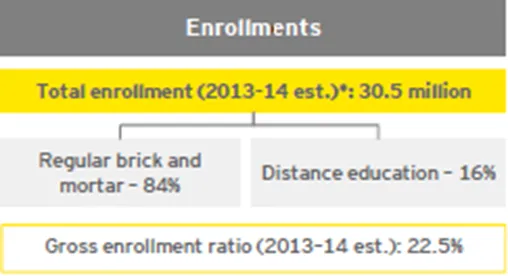Online education – the way forward for 10 million hungry Indian minds
Education is the key to inclusive growth in any society. India is a young country with nearly 300 million people in the 19-35 age group. Based on the recent FICCI–EY report, currently India’s gross enrolment at 22 percent (30 million) is one of the lowest in the world, compared to 90 percent in the US, 62 percent in the UK and 31 percent in China. If we need to push our ratio even high enough to match China's, then that amounts to educating an additional 15 million students – which seems like an overwhelming task, especially through our traditional brick-and-mortar education system.

The traditional education throws two major hurdles our way – accessibility and financial affordability. Business education is very expensive in India, especially considering the ROI on them. The tuition fees for premier B-schools in India are very high and they spike periodically. This situation pushes a majority of applicants to the lower tier schools, which have a mixed track record with respect to their placements. A working professional who is evaluating going to a business school in India may be extremely discouraged when (s)he takes into account the tuition costs, living expenses and most importantly the loss of pay during the period of education in a full-time programme. Of course, the lucky few who bag a great placement after the course may get a strong ROI for their time and money invested in a top tier B-school.

If we consider the distance learning method in India, it lacks the quality to deliver desired results. Of the 30 million higher education students, approximately five million are distance learning students. This means they receive self-study materials and enroll for end-of-term examinations. The system seems scalable and eliminates the need for additional infrastructure, but the students barely learn anything, have no professional guidance and lack the skills to tackle real-world problems. These students often end up in the lowest rung in terms of employability.
Technological disruption in education – our only ray of hope
Technology has disrupted industries across the globe and even in India, especially the retail, information accessibility and communication sectors. Now a fundamental change driven by technology has entered the education sector.
The latest developments in technology offer competitive and effective alternatives to traditional teaching. Today, we have blended learning, online courses and Massive Open Online Course (MOOCs). Each leverages IT infrastructure in varying degrees. Online learning is sweeping away the ground beneath us as we know it and replacing it with globalised, technology-enabled world of teaching and learning.
The year 2015 alone has witnessed nearly 591 edtech startups in India.

The annual increase in the edtech startups indicates that Indian students are voracious online learners. Class Central indicates that nearly 35 million students across the world have enrolled for online courses in 2015, as compared to 15 million in 2014. And nearly 10 percent of these students are Indians! Over the last few years, online learning has shown impressive growth numbers, thus drawing investors’ attention. Mark Zuckerberg and his wife's, Priscilla Chan, Chan Zuckerberg Initiative, made its first investment in Asia in Bengaluru-based Byju’s, a mobile-based online learning company. This company is already backed by Sequoia Capital and Sofina, among others – and this is a clear indication of how this sector is being perceived.
With the increasing need to up-skill and further increasing number of students seeking education, there has been a tremendous rise of interest in online learning. The widespread connectivity of Internet access and the various international educational institutions joining open online learning have equipped Coursera – the market leader in online learning – with 1,500 courses from universities and schools across the world; they currently cater to 1.5 million students in India. Other top players in this sector such as edX and Khan Academy have similar success in terms of enrollment numbers and the wide array of courses offered. Byju’s, however, has a different model than these MOOC platforms, as it generates its own content for the video classes and tests offered on its Learning App, which has already surpassed 5.5 million downloads and has over 2,50,000 annual paid subscriptions.
Online education is the future – but is it MOOCs?
Online learning is definitely the way to bring high-end education and learning to the masses with comparatively lower costs. MOOCs does fulfil a few of these requirements, especially when it comes to cost and accessibility. However, the following are the few areas where it starts to fall apart:
a) Low completion rates: Most of the MOOCs are in self-study pattern with negligible interaction and feedback process. Thereby, only five percent of enrolled students successfully complete a free MOOC.
b) Poor learning outcome: The learning progress and understanding of concepts are hardly assessed in terms of real world applications and synthesizing the learning – even for the five percent of students who manage to complete the course.
To back this aspect, we have similar cases from San Jose University and University of California. Both the universities tried the MOOC approach to save college tuition cost, while the latter even invested $7 million in the experiment. Both ended the setup within a year and three years, respectively, due to large number of failures and poor learning outcomes.
c) Few assessments and little feedback: MOOC completion is only tied to watching videos and answering quizzes. There’s no way to gauge your understanding of key concepts, process information gathered to help with decision-making, creativity, interpersonal skills etc. These are the key factors missing with MOOC approach – structured assessment and personalised feedback.
d) Peer-to-peer learning: Quality education facilitators strongly believe that you can learn as much from your peers as you can from the faculty; especially, when it comes to workplace and career skills. Peer-to-peer interaction is inevitable to attain professional, interpersonal, negotiation and leadership skills. Unfortunately, MOOCs are predominantly a one-way street and a lonely one at that.
This does not mean that online learning is ineffective. However, it does mean we need to take this platform a step forward in terms of innovation, personalised attention, group interaction, detailed and timely feedback, real-world applications etc. One of things that traditional approach got right was that teaching is based on innate human creativity and calls for a personal touch.
So when the two worlds combine – real faculty and the online platform – what we get is the revolutionary Small Private Online Courses (SPOCs).
SPOC offers much more
The SPOC trend is on a rise. SPOCs deliver faculty lectures on video, leverage technology for their learning platforms and provide insights from the world’s best faculty and Ivy League schools. However, in addition, they also offer many aspects that make up a holistic learning that the MOOCs don’t.
A great example would be Harvard Business School’s HBX Core offering. An MBA from the prestigious Harvard School might cost around $150,000 or more and might raise the issue of affordability. So, instead going the MOOC way like many IVY schools have, Harvard decided to create a SPOC. HBX Core has an entrance exam, group discussions, grading and feedback and a proctored final exam. Class sizes are about 300 on average, larger than the typical HBS MBA class but much smaller than a MOOC classroom. But the key success indicator – a 90-percent completion rate. HBX Core costs $1,800 and has enrolled more than 10,000 students so far.
Another example in this category is EMERITUS, which collaborates with MIT Sloan, Columbia Business School and Tuck at Dartmouth to offer inexpensive upskilling and reskilling courses to working professionals. Similar to HBS, it admits students through an entrance exam and students work in small cohorts of six. Courses have simulations and live tutoring to make the learning stick, and a mobile app to foster social learning. Additionally, its grading system is not limited to multiple choice questions, and rather is based on project work, proctored exams and manual grading of assignments.
It’s just the beginning of a revolution
The edtech sector is just now being explored and we have a long way to go. The traditional education system might not change immediately. However, the way knowledge is consumed is definitely undergoing a transformation. SPOC is a model that goes a bit further than MOOC, after the innovators realise the elements missing in the latter. If the momentum of innovation continues, we might definitely have a lot to look forward to. But in the end no matter the technology we adopt – the student will be the winner!
(Disclaimer: The views and opinions expressed in this article are those of the author and do not necessarily reflect the views of YourStory.)









![[Weekly funding roundup April 20-26] VC investment dips as startups resort to debt capital](https://images.yourstory.com/cs/2/220356402d6d11e9aa979329348d4c3e/funding-lead-image-1669386008401.jpg)

